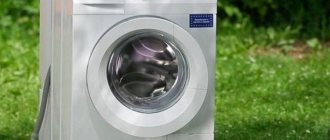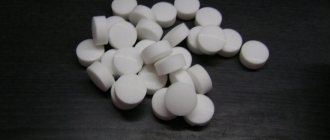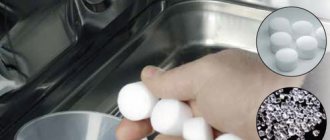The dishwasher saves not only the user’s personal time, but also water. Considering the current cost of the resource, we must recognize the feasibility of using this kitchen appliance, because... it uses very little water compared to manual washing.
- What is the water consumption of a dishwasher?
- How savings are achieved
- Comparison with hand washing
- Calculation of savings in money
- Expert advice
- Dishwasher catalog with reviews
What is the water consumption of a dishwasher?
The range of dishwashers presented by different manufacturers includes narrow, compact and full-size options that differ, among other characteristics, in chamber capacity. We can say that water consumption depends on this indicator.
For 60 cm
Full-size dishwashers can clean 10 to 14 sets of dishes in one cycle and use 9-14 liters of water. Some expensive full-size PMMs consume only 6.5-7 liters, depending on technical capabilities.
A small family should not purchase a machine with a large chamber, so as not to waste excess water. Having dirty dishes pile up for days is not very pleasant, and it can also lead to a bad smell in your car.
hio 3c23 wf
For 45 cm
As a rule, water consumption in narrow PMM models of different brands is small - up to 9 liters per working cycle. This technique can accommodate up to 9 sets of dishes and consumes 0.69 kWh during the normal program, which lasts an average of 205 minutes.
Compact PMM
The washing chamber of compact dishwashers can accommodate 6-8 sets of dishes. At the same time, the machines consume the same amount of water as narrow or full-size economical versions - 6.5-9 liters. It turns out that the same amount of resources is consumed, and less dishes are washed.
But still, consumption depends to a greater extent on such design characteristics as efficiency than on dimensions and capacity. The more efficiently a technology saves resources, the higher its cost.
4 SKS62E88
By mode
Water consumption during machine washing depends on the selected program. The half-load mode allows you to reduce water costs by 20-30%.
The function of intelligent load assessment, provided in the premium PMM, is that the device automatically determines the required volume of water depending on the amount and degree of soiling of the dishes.
Manufacturers equip their equipment with different programs and options, but water is consumed approximately as follows:
- “Light pollution” will require 7 liters.
- In “Economic” mode, 8-9 liters will be spent.
- The “Auto” option assumes consumption of 6-11 liters.
- With “Intensive” washing, resource costs will increase to 10-11 liters.
Have you set the water hardness in PMM?
Yes, of course. No.
By brand
Each manufacturer produces PMMs with different characteristics, but in general all companies strive to minimize water costs using innovative solutions. If we summarize the performance of dishwashers of different brands, the average water consumption of the appliance can be represented as follows:
- Bosch - about 10 l;
- Siemens – 7 l;
- Candy – 8-13 l;
- Beko – up to 12 l;
- Electrolux – up to 10 l;
- Indesit – 7 l.
- Ariston - 8-10 l.
hsie 2b19
How much water does a dishwasher use?
If you compare the characteristics of PMMs of different models, you will find that each of them consumes a certain amount of liquid during one cycle. Consumption is directly related to the dimensions of the machine; the larger the chamber and capacity of the device, the greater the water consumption. Let's see how many liters a regular and compact model consumes per cycle.
Conventional PMM
The category of conventional dishwashers includes the following devices:
- Full size. In such devices you can wash from 10 to 14 sets of dishes at a time.
- Narrow. These are floor-standing devices designed for 9 sets.
The volume consumed by such machines is 9–14 liters. Usually we are talking about cold water - it is more profitable to connect the PMM only to its source. Heating carried out by the device itself is cheaper if a hot water meter is installed.
Candy CDP 2L952 W is one of the most popular PMM models. Yandex.Market labeled it with the “Customers’ Choice” label. This machine is not only affordable, but also economical, here are its characteristics:
| Type | narrow |
| Installation | freestanding |
| Capacity, sets | 9 |
| Energy consumption | A |
| Washing/drying | A/A |
| Water consumption per cycle, l | 9 |
| Dimensions (WxDxH), cm | 45x62x85 |
| Programs | 5 |
| Approximate cost, rubles | 15 000 |
This model has the minimum water consumption for conventional dishwashers - only 9 liters. Model in white with electronic control, but without display. Consumes 0.69 kW/h per cycle. Wash on the normal program - 205 minutes. Noise - 52 dB.
One set includes approximately the following set of items - two plates of different sizes, a cup, saucer, glass, and a standard set of cutlery. The “package contents” may vary depending on the brand - but the differences are minor. To wash so many items with your hands, you will have to use a lot of water and time, and if you use a boiler, then electricity.
Economical PMM
9 liters per cycle is not the limit. Today there are devices on the market that consume no more than 7 liters per cycle. These may be models:
- premium class;
- compact.
That's why low flow doesn't always mean low capacity. There are modifications that can wash a lot of dishes using a minimum of liquid resources. True, such devices are not cheap. Among them is the economical full-size machine Siemens SN 236I00 ME - having a solid capacity, it consumes only 6.5 liters. The device owes its capacity to the third loading level.
Siemens SN 236I00 ME has electronic control. Washing on the standard program - 195 minutes. It works very quietly, the noise level is only 44 dB. Energy consumption - 0.92 kW/h. Other technical specifications:
| Type | full size |
| Installation | freestanding |
| Capacity, sets | 13 |
| Energy consumption | A++ |
| Washing/drying | A/A |
| Water consumption per cycle, l | 6,5 |
| Dimensions (WxDxH), cm | 60x60x85 |
| Programs | 6 |
| Approximate cost, rubles | 49 500 |
Economical dishwashers use 40% less water than conventional versions.
Compact models
These dishwashers differ from full-size and narrow dishwashers in their capacity - they can wash 6-8 sets. Moreover, their consumption is the same as that of narrow or economical versions - from 6.5 to 9 liters. That is, while consuming the same amount as large machines, they wash much less dishes.
Bosch Serie 2 SKS 41E11 is a compact machine that costs more than many full-size and narrow modifications and still consumes 8 liters. Compactness does not mean that the model uses little water. Consumption depends on design solutions, and the more economical the device, the more expensive it is.
| Type | compact |
| Installation | freestanding |
| Capacity, sets | 6 |
| Energy consumption | A++ |
| Washing/drying | A/A |
| Water consumption per cycle, l | 8 |
| Dimensions (WxDxH), cm | 55x50x45 |
| Programs | 4 |
| Approximate cost, rubles | 22 000 |
To control water consumption, the manufacturer installs a Bosch water flow sensor - it is placed in a plastic case and consists of a water rotor and a Hall sensor.
How savings are achieved
The dishwasher uses water more economically thanks to the following operating features:
- The water in the device is reused many times, purified using filters.
- Water is sprayed under high pressure.
Water in the PMM is used at three stages:
- pre-spraying;
- main washing cycle;
- rinsing.
After completing the first operation, the machine does not drain the water into the sewer, but passes it through a filtration system and reuses it. After washing dirty dishes, the equipment partially drains the liquid and adds a fresh portion from the water supply to the remainder.
Expert opinion
I work in the household appliance repair industry. Extensive experience in restoring washing machines and dishwashers.
Ask a Question
Thanks to the high flow rate of water from the sprinklers, the quality of washing dishes is improved and the process is accelerated, as well as resource consumption is reduced.
Comparison with hand washing
In addition to the fact that the dishwasher uses water repeatedly and therefore consumes a small volume, the device only draws cold water for its operation, heating it to the desired temperature. This solution is cheaper for the user.
Even if you take into account the energy consumption for heating, this method will still be cheaper than using hot water. In addition, hot water from the tap is dirtier; its impurities can quickly clog PMM filters.
Practice shows that when washing the same volume of dirty dishes, a machine consumes 10 times less water than the housewife using the manual method. At the same time, self-washing involves the use of more expensive hot water.
Is a dishwasher profitable?
Oh yes! No
When washing dishes by hand, up to 100 liters of mixed water goes down the drain. The appliance will clean the same number of kitchen utensils, spending approximately 10 liters. Consumption depends on the model and selected mode.
Experts believe that a dishwasher pays for itself within 4 years on average. Household appliances stores regularly hold promotions and make attractive offers to customers.
Will a dishwasher help you save on water?
We calculate in which cases it is more profitable to wash dishes by hand, and when it is better to resort to the benefits of civilization.
– There are often advertisements for dishwasher detergent on TV, in which they claim that this miracle unit will help you significantly save on water. Is this really true?
To calculate costs, the portal's editors conducted a small experiment: we compared water meter readings before and after washing dishes. Of course, the number of people in a family is different for everyone, as is the number of dishes. But there are also general points. So, in addition to a set of dishes for each family member (plate, mug, fork or spoon), there are also related items: pots, pans, their lids, cutting boards, knives, etc., and cold and hot water (for those who do not have it turned off ) are spent approximately equally.
It is also worth considering that in winter, as a rule, we use more hot water than in summer, and tariffs in different areas of the city may differ. Thus, in the Novovyatsky district the cost of a cubic meter of cold water is 33.66 rubles, in Kirov - 28.42 rubles. In addition, we do not take into account the cost of dishwashing detergents - neither for the “manual” method, nor for the dishwasher. Our calculations will only concern water costs.
To wash the dishes after dinner for a family of two, it took 35 liters of water: 18 liters of cold and 17 liters of hot. The Kirov tariff for hot water is 163.98 rubles per cubic meter, for cold water - 28.42 rubles. In addition, you need to take into account the costs of sewerage at a tariff of 21.80 rubles. per cubic meter.
Let's do the math:
0.017x163.98 + 0.018x28.42 + 0.035x21.80 = 4.06 rubles
That's how much we spent on washing two sets of dishes.
Now let's move on to dishwashers. Water consumption will depend on the model and year of its manufacture: older cars consume more water than
On this topic
Will a water heater help you save on hot water?
9166
new models, but, as a rule, costs do not exceed 20 liters, and this is in the most uneconomical option. For modern dishwashers, 6.5 liters per cycle is sufficient. In addition, the selected mode also affects water consumption: for severe pollution, an intensive mode is used, which requires more water. On average, a small dishwasher (about 45 cm wide) can fit about nine sets of dishes, and if you are willing to leave unwashed cups and plates until the evening, you can wash all the dishes that have accumulated during the day in one go.
To calculate the cost of water for a dishwasher, we took average figures: 10 liters of cold water (it is heated directly in the machine).
0.010x28.42 + 0.010x21.80 = 0.5 ruble
It turns out that a dishwasher is more than 8 times more economical than the usual “manual” method.
It’s also worth noting that our little experiment was conducted on a weekday evening. On weekends, when you have breakfast, lunch and dinner at home, a lot more dishes get dirty. Accordingly, water consumption increases.
However, this “pure” comparison did not take into account energy costs. And in the case of a dishwasher, they are significant, because it has to heat the water itself.
A small dishwasher with 6 sets consumes approximately 0.6 kWh per cycle. The electricity tariff in Kirov from July 2021 is 3.95 rubles/kWh.
0.6x3.95 = 2.37 rubles
Thus, the total cost of water and electricity per cycle for the dishwasher will be
2.37 + 0.5 = 2.87 rubles
In total, according to our calculations, it turned out that with a dishwasher we save approximately 1.69 rubles per day. However, we note once again that for the calculation we took two sets of dishes and the cost of water for washing them only once a day. In the case of a “wholesale” load of the dishwasher, the savings will be 2-3 times higher.
We also decided to calculate how long it would take for such savings to pay for a dishwasher. On the websites of Kirov household appliance stores, prices range from 15 to 130 thousand rubles (excluding all kinds of promotions and discounts). A machine worth 15 thousand will pay for itself in 8,876 washes, and the most expensive unit - in 76,924 times. If we translate this into time indicators (when calculating 2 dishes per day), it turns out that the cheapest dishwasher will pay for itself in 12 years, and the most expensive one in 105. Frankly speaking, not quickly.
Briefly about the main thing:
1. To calculate costs, we took two sets of dishes with other kitchen utensils. Only one wash per weekday was taken into account.
2. The water and electricity consumption of a dishwasher depends on its capacity and year of manufacture. Given the total costs, such equipment will not pay for itself quickly.
3. Costs directly for water with the “manual” method of washing dishes exceed the costs of a dishwasher by more than 8 times.
If you have questions that you can't find the answer to, ask us and we will try to answer them.
Photo: propositive.ru
On this topic
2647
What to do if the deadline for major home repairs is constantly being postponed?
Calculation of savings in money
The annual water consumption for washing dishes is as follows:
- in the car - 10 l * 365 days = 3650 l of cold water;
- manually – 100 l * 365 days = 36500 l of mixed water.
Let's assume that the cost of a cubic meter of resource in the user's region is:
- cold water supply – 20 rub./m³;
- hot water supply – 70 rub./m³.
Let's calculate the annual water consumption in monetary terms:
- PMM – 3,650 m³ * 20 rub./m³ = 73 rub.
- Manual washing – 36,500 m³ * 70 RUR/m³ = 2555 RUR.
Obviously, using kitchen appliances brings big savings. This calculation does not take into account the difference in the cost of detergents: tablets, rinse aid and special salt for water softening.
Are there savings?
Now let’s analyze, if the difference is in how much water a dishwasher spends and how much a person spends on washing the same amount of dishes, does the machine actually save water or not? You can only talk about saving water consumption if you have water meters; if you don’t have them, then the water consumption of the dishwasher doesn’t matter.
If we take, for example, a narrow Siemens SN 66M094 dishwasher with a capacity of 14 sets and load 63 items into it, for example:
- 18 plates,
- 14 cups,
- 2 pans,
- 3 salad bowls,
- 1 cutting board,
- 1 teapot,
- 24 cutlery,
then in about three hours with intensive mode it will spend 10 liters of water.
We tried to wash half of the set of dishes that the dishwasher washed, that is, 34 items. The whole process took 20 minutes. At the same time, the water was turned off when the dishes needed to be washed. As a result, 23 liters of hot and 20 liters of cold water were spent, a total of 43 liters. For just one wash, the figure seems impressive.
If we convert the savings from liters to rubles, this is what we got: for 1 year of daily operation of the machine, you can save 8280 liters, the average cost of hot water for 2021 in Moscow is 130 rubles. This means that the dishwasher saves 1,076 rubles in your budget on hot water. Savings on cold water will be 108 rubles.
Conclusion! A dishwasher will save 1,184 rubles on water per year. But this is subject to the economical use of water when washing by hand; there are those who spend 100 liters of water a day washing dishes, which means that the machine will save even more.
Of course, this is a small amount, and in order to talk about real savings, you also need to calculate the electricity consumption and the cost of detergents. As for electricity, water savings cover electricity consumption by about 3-4 times. There will be about 830 rubles left for detergents. This money may not be enough for a year, depending on what to wash and what to sprinkle, but we can say that the total costs of hand and machine washing are approximately equal. However, there is still a big advantage in favor of a dishwasher; it will save you time, which you can spend with pleasure.
Thus, even according to the most conservative estimates (with a water consumption of 14 liters), the dishwasher saves water. But whether your family budget saves or not, calculate for yourself. Everything will depend not so much on the model of the machine, but on what detergents you use to wash dishes. In our opinion, are these costs worth a few minutes of rest after work?
Interesting:
- Dishwasher rating 45 cm
- Dishwasher power in kW
- Is it worth buying a dishwasher?
- Which company to choose and buy a dishwasher
- Which dishwasher is better - Bosch, Siemens,...
- Is a dishwasher necessary for a family of three?
Reader comments
- Share your opinion - leave a comment
Expert advice
When choosing a dishwasher in a store, pay attention to such indicators as:
- washing class;
- Economy mode and half load option available.
The operation of class A appliances is characterized by the lowest water consumption. According to this indicator (from A to G), dishwashers are divided into:
- economical;
- average degree of efficiency;
- low-cost.
In recent years, kitchen appliance manufacturers have been producing devices that use water resources as efficiently as possible.
Special modes will help reduce the amount of water consumed:
- economical;
- for light contamination;
- half load.
Remember also that proper placement of dishes will ensure ideal washing results and make it possible to reduce water consumption. Recommendations for the distribution of kitchen utensils in the washing compartment can be found in the user manual.
There are many benefits of using a dishwasher in your home. In addition to saving time and the ability to go about their business, the user receives a reduction in water consumption. The technology uses an expensive resource efficiently and repeatedly.
How does water consumption depend on washing modes?
Fluid consumption is affected by the presence and use of additional modes. Thus, thanks to “half load”, costs are reduced by 20–30%. Savings are also achieved due to the function of “intelligent assessment” of the load: the device itself decides how much liquid is needed for the cycle in order to wash the dishes efficiently and effectively. Premium models of all types are usually equipped with similar functions - full-size, narrow, compact.
The set of functions and programs for each modification is determined by the manufacturer. The following modes affect water consumption:
- Economy mode. Wash at 50 degrees. Consumption - 8–9 l.
- Auto mode. Suitable for both tableware and frying pans. Involves pre-washing, rinsing and drying. Consumption - 6–11 l.
- Intensive wash. Costs rise to 10–11 liters.
- Light contamination. Only 7 liters are spent.











